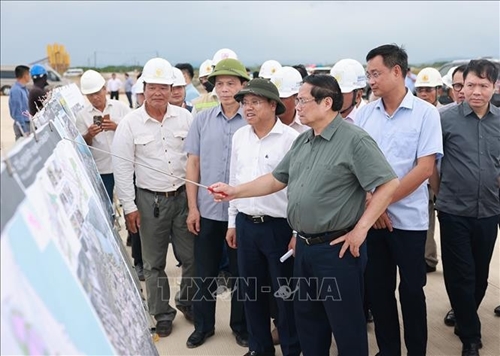At the intersection of the Van Ninh–Cam Lo expressway and Provincial Road 575 in Con Tien commune, the PM directed Quang Tri authorities to urgently complete site clearance, particularly for auxiliary roads, vehicle turnarounds, and toll stations. Contractors were directed to mobilize maximum workforce to finalize remaining components, install traffic safety systems and signage promptly, and ensure construction quality, occupational safety, and environmental hygiene.
    |
 |
|
Prime Minister Pham Minh Chinh inspects the construction of the Quang Tri Airport Urban–Aviation Industrial Complex Project, July 26. |
Emphasizing the importance of progress, PM Pham Minh Chinh requested that contractors bring in additional local partners and complete the entire route by August 19. Once operational, the expressway segment will link with the North–South Expressway, creating momentum for trade, socio-economic development, tourism, and investment attraction in both Quang Tri and neighboring localities.
In tandem with completing the expressway, Quang Tri authorities and relevant agencies were instructed to prepare for and carry out land clearance for the North–South high-speed railway and coastal road projects. They were also tasked with planning new development zones enabled by the new infrastructure, including industrial parks, urban areas, and tourism complexes, to generate jobs and improve livelihoods.
The Van Ninh–Cam Lo section of the North–South Expressway spans 65.5 km within Quang Tri province. With a total investment nearing 10 trillion VND (382.4 million USD), the project began construction on January 1, 2023, and is slated for completion in this October. As of now, over 97% of contractual works have been completed, with contractors striving to finalize the main route in July to ensure traffic is open by August 19.
Inspecting the construction site of Quang Tri Airport, the PM directed the development of a broader economic zone around the airport, including aviation industry hubs, airport city developments, high-tech industrial areas, and service sectors. He emphasized the need for strategic infrastructure to support future regional development and facilitate connectivity with Laos and Thailand.
The Prime Minister requested that Quang Tri Airport be developed to meet ICAO class 4F standards. In the immediate term, he ordered acceleration of Phase 1, with a firm deadline for completion by July 2026.
Quang Tri Airport is among the airports listed in Vietnam’s national airport master plan for 2021–2030, with a vision to 2050. It is designed as a civil airport of class 4C and a level-II military airbase, covering 316.57 ha, with a total investment of 5.821 trillion VND (222.6 trillion USD).
The same day, PM Pham Minh Chinh inspected the Phase 1 construction of the My Thuy Port complex in My Thuy commune.
My Thuy Port is planned to cover 685 ha, featuring 10 wharves capable of handling ships up to 100,000 DWT, with an annual throughput of 30 million tons. The total project investment stands at 15 trillion VND (573.7 million USD).
The Government leader highlighted My Thuy Port’s strategic location, complementing other seaports in the region and offering favorable conditions for multimodal transport connectivity. He noted the port’s vital role in linking Vietnam’s economy with ASEAN markets.
He urged the investor and contractors to operate in “three shifts, four crews,” ensuring construction progress, quality, technical standards, aesthetics, labor safety, disaster preparedness, and environmental sanitation. He called for the port to be developed to modern standards, aligned with green transition goals, digital transformation, and smart governance. He also directed the planning of a free trade zone and dedicated port facilities at My Thuy.
Stressing that the project will help reduce logistics costs and enhance the competitiveness of products, enterprises, and the economy, the PM called for investments in road networks connecting My Thuy Port to regional transport routes and development zones, including links to the Lao Bao border gate, to capitalize on goods flows from Laos and northeastern Thailand.
Source: VNA